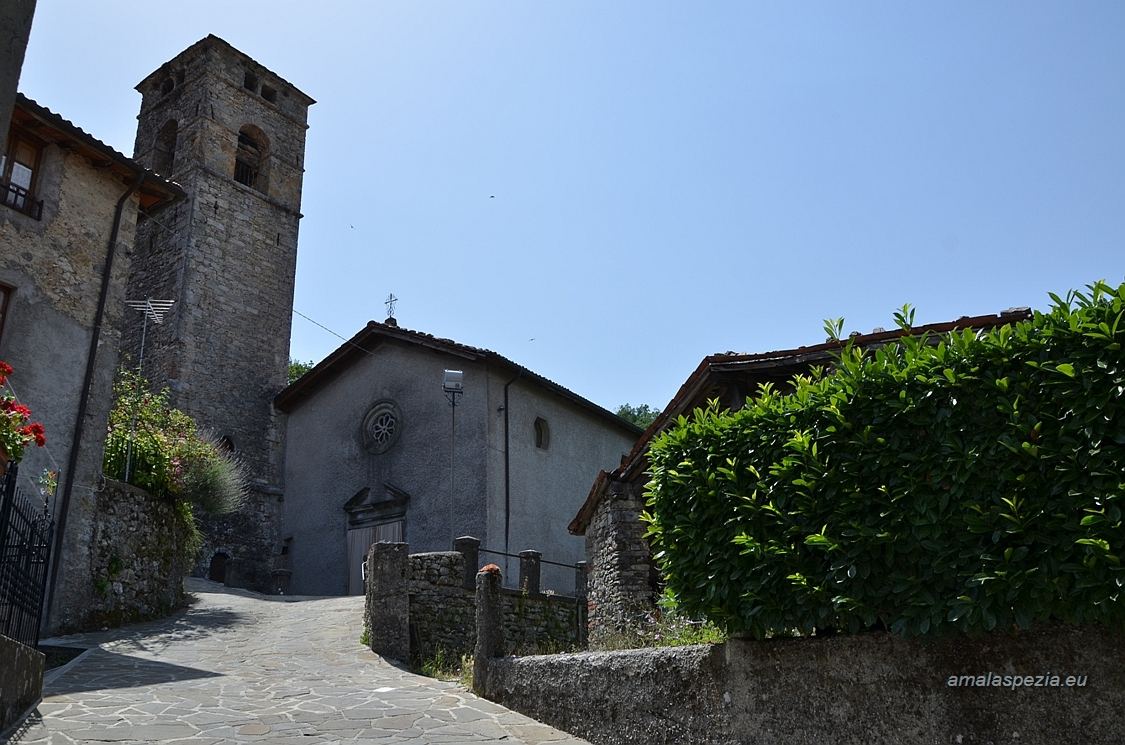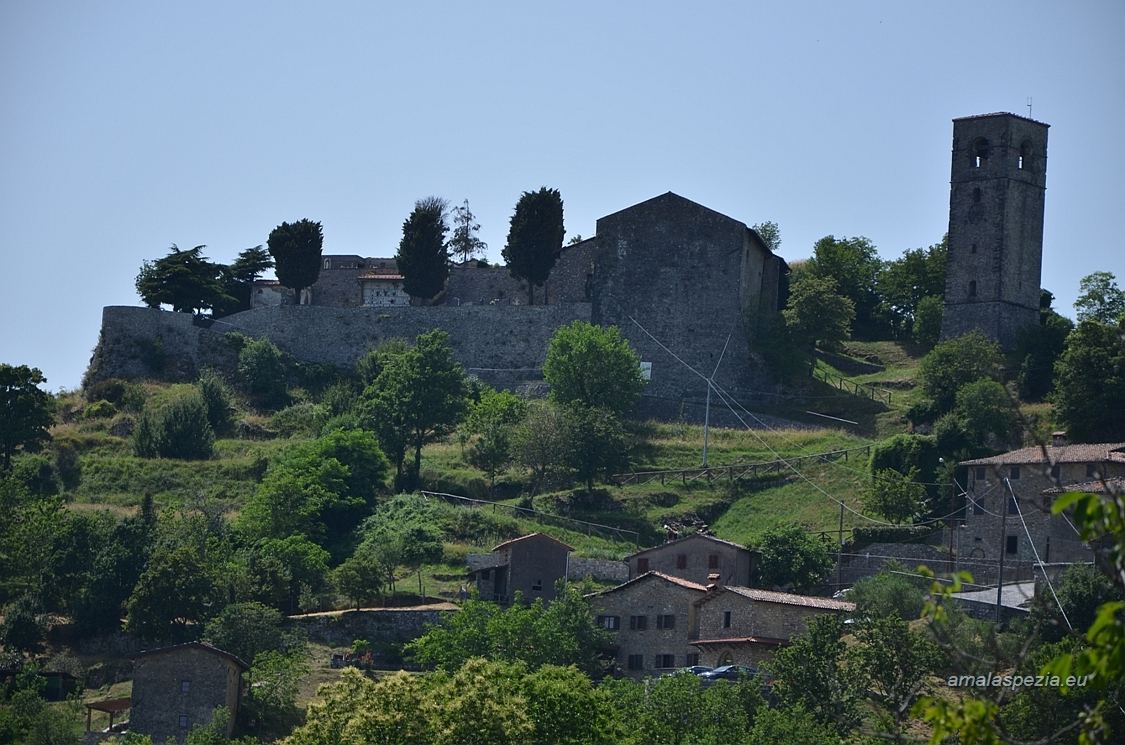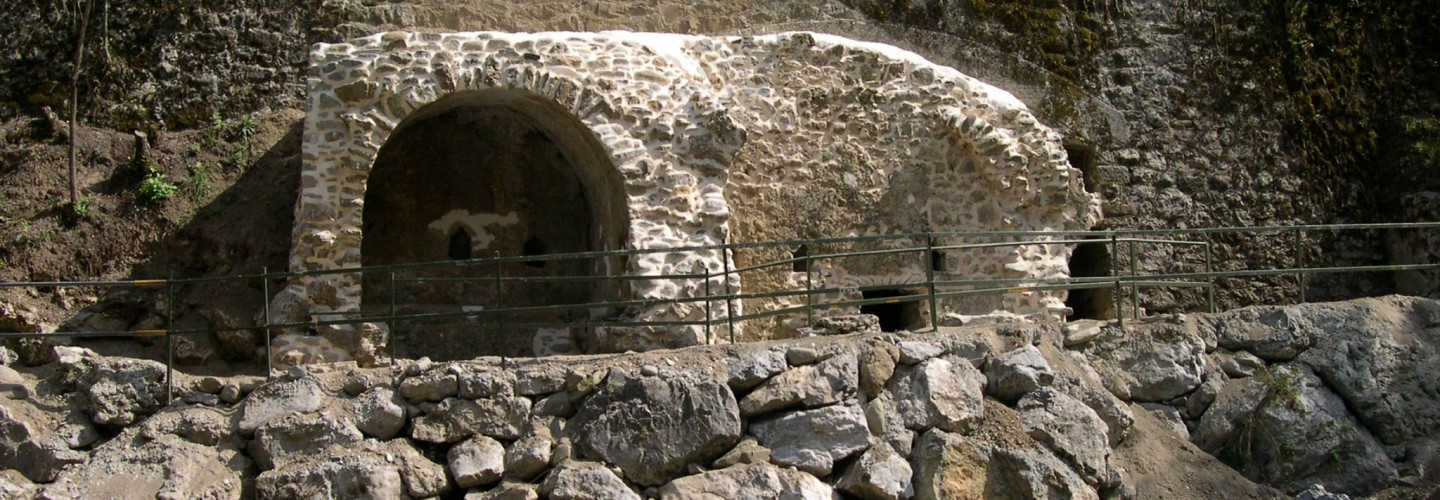
Track details
Distance
19.4km
Duration
6h 00min
Ascent
979m
Descent
980m
Starting altitude
281m
Arrival altitude
279m
Lowest point
275m
Highest point
790m
Eglio
It is an ancient country, mentioned in a document from 884, built on the ridge of a mountain, which has, on the opposite side, a horrid overhang of 470 meters and a horizontal development of over 700.
It is known that, around the year 1000, the main nucleus, that is the Sassi-sopra castle, to which the houses of serfs had perched, belonged to the family of the Porcaresi nobles. It dominated the whole territory from Pania down to Serchio and also included the villages of Verni, Valico and Trassilico.
The Porcaresi dispersed, perhaps more due to the changed economic conditions of the feudal lords in general than to actual war events, the “Municipality of Sassi” (such is indicated in the documents) became part (with Gallicano, Molazzana, Montaltissimo and Calomini ) of the territories of the “Gran Matelda” (Matilde of Canossa). The document, drawn up and sealed at “Villa Foxana” (today: Fosciana) bears the date of 10 July 1105. As soon as the new land came into legal possession, the “Gran Contessa” repaired and enlarged the old church of “San Frigdiano in Saxo “.
In 1385 the town was occupied by the troops of Bernabò Visconti and the sons of Castruccio Antelminelli; “strict security measures were taken and – as the historian Sercambi writes -” the destruction of the Rocca was ordered, a constant nest of turbulent and restless inhabitants “.
In 1393, however, it had already been rebuilt and the bishop of Lucca passed it as a fief to the nobles of Dalli.
On July 24, 1451, with nine other countries, Sassi gave himself to the Marquis Borso d’Este, who formed the vicar of the New Lands.
On July 28, 1524 Sassi had the honor of hosting Ludovico Ariosto, who in his capacity as Governor of the Garfagnana had risen from Castelnuovo on the back of a mule, accompanied by a “driver, a secretary, two crossbowmen, to visit that fortress” , which – he wrote – “in a much stronger and horrid place than the Verrucole.”
The Poet would have liked it to be restored to good condition, appointed a castellan and would have warned a number of gunmen there. But the Duke did not want to know about the expenses in Garfagnana, let alone in Sassi, so he gave it, with the annexed territories, to a Sassese, certainly Jacopo da Mariano, “to have her father defended him with rare fearlessness, against the Lucchesi” and so faithfully “that he bit”.
An important clause in the transfer document is this: “on condition that, in need, they can close them in there to take refuge with their substances, including beasts”. And this suggests that the various housings were still in good condition.
But “their neighbors”, on the other hand, preferred to build their homes a little lower, where the soil was more fertile, the water more abundant.
And so Sassi was born, the one “below”, which is the current one.
It is a belief that the church of San Frediano in Sassi had, in the past, ornaments, paintings and furnishings of considerable value.
The silk makers of Lucca (the Bonvisi, the Talenti, the Cenami) who in the twelfth and thirteenth centuries supplied their drapes to the cathedrals and nobles of half of Europe, also woven cloaks, stoles and planets for various churches in the Val di Serchio and, of course, also for this, linked to the name of the “Grand Countess” and dedicated to a bishop from Lucca.
Some, therefore, of these furnishings have remained (an embossed silver processional cross from the 1400s with numerous sacred figures; a planet (perhaps from the same century, woven in silk, filigreed in gold), but others have been irreparably lost.
In the second half of the fifteenth century a certain Baptist Bartolomei (“operaius ecclesiae Sancti Frigdiani”) was a worker who, as said in a contract of the notary Ser Lucenzio Best, on December 28, 1814, commissioned Matteo Civitali to sculpt a tabernacle in Carrara marble, “pulcrum et compositum et ornatum” (beautiful, well made and decorated), to be placed (clearly said) in the church “de Sassi in Gharfagniana”. Agreed compensation: eight golden ducats.
Today that tabernacle is no longer there, in any of the churches in the town, neither in that of Sassi-sopra, nor in that of S.Rocco, nor in that which overlooks the ancient farmhouses of Granciglia.
In the year 1827 the new parish church was opened for worship and it is also dedicated to St. Frediano. The ornaments, the altars, the paintings of the old one were transported there, but the tabernacle of the great Civitali, either was lost in the removal, or had already disappeared since that time.
Eglio

It is an ancient country, mentioned in a document from 884, built on the ridge of a mountain, which has, on the opposite side, a horrid overhang of 470 meters and a horizontal development of over 700.
It is known that, around the year 1000, the main nucleus, that is the Sassi-sopra castle, to which the houses of serfs had perched, belonged to the family of the Porcaresi nobles. It dominated the whole territory from Pania down to Serchio and also included the villages of Verni, Valico and Trassilico.
The Porcaresi dispersed, perhaps more due to the changed economic conditions of the feudal lords in general than to actual war events, the “Municipality of Sassi” (such is indicated in the documents) became part (with Gallicano, Molazzana, Montaltissimo and Calomini ) of the territories of the “Gran Matelda” (Matilde of Canossa). The document, drawn up and sealed at “Villa Foxana” (today: Fosciana) bears the date of 10 July 1105. As soon as the new land came into legal possession, the “Gran Contessa” repaired and enlarged the old church of “San Frigdiano in Saxo “.
In 1385 the town was occupied by the troops of Bernabò Visconti and the sons of Castruccio Antelminelli; “strict security measures were taken and – as the historian Sercambi writes -” the destruction of the Rocca was ordered, a constant nest of turbulent and restless inhabitants “.
In 1393, however, it had already been rebuilt and the bishop of Lucca passed it as a fief to the nobles of Dalli.
On July 24, 1451, with nine other countries, Sassi gave himself to the Marquis Borso d’Este, who formed the vicar of the New Lands.
On July 28, 1524 Sassi had the honor of hosting Ludovico Ariosto, who in his capacity as Governor of the Garfagnana had risen from Castelnuovo on the back of a mule, accompanied by a “driver, a secretary, two crossbowmen, to visit that fortress” , which – he wrote – “in a much stronger and horrid place than the Verrucole.”
The Poet would have liked it to be restored to good condition, appointed a castellan and would have warned a number of gunmen there. But the Duke did not want to know about the expenses in Garfagnana, let alone in Sassi, so he gave it, with the annexed territories, to a Sassese, certainly Jacopo da Mariano, “to have her father defended him with rare fearlessness, against the Lucchesi” and so faithfully “that he bit”.
An important clause in the transfer document is this: “on condition that, in need, they can close them in there to take refuge with their substances, including beasts”. And this suggests that the various housings were still in good condition.
But “their neighbors”, on the other hand, preferred to build their homes a little lower, where the soil was more fertile, the water more abundant.
And so Sassi was born, the one “below”, which is the current one.
It is a belief that the church of San Frediano in Sassi had, in the past, ornaments, paintings and furnishings of considerable value.
The silk makers of Lucca (the Bonvisi, the Talenti, the Cenami) who in the twelfth and thirteenth centuries supplied their drapes to the cathedrals and nobles of half of Europe, also woven cloaks, stoles and planets for various churches in the Val di Serchio and, of course, also for this, linked to the name of the “Grand Countess” and dedicated to a bishop from Lucca.
Some, therefore, of these furnishings have remained (an embossed silver processional cross from the 1400s with numerous sacred figures; a planet (perhaps from the same century, woven in silk, filigreed in gold), but others have been irreparably lost.
In the second half of the fifteenth century a certain Baptist Bartolomei (“operaius ecclesiae Sancti Frigdiani”) was a worker who, as said in a contract of the notary Ser Lucenzio Best, on December 28, 1814, commissioned Matteo Civitali to sculpt a tabernacle in Carrara marble, “pulcrum et compositum et ornatum” (beautiful, well made and decorated), to be placed (clearly said) in the church “de Sassi in Gharfagniana”. Agreed compensation: eight golden ducats.
Today that tabernacle is no longer there, in any of the churches in the town, neither in that of Sassi-sopra, nor in that of S.Rocco, nor in that which overlooks the ancient farmhouses of Granciglia.
In the year 1827 the new parish church was opened for worship and it is also dedicated to St. Frediano. The ornaments, the altars, the paintings of the old one were transported there, but the tabernacle of the great Civitali, either was lost in the removal, or had already disappeared since that time.
Sassi
Sassi di Sopra appears perched on a rocky outcrop where the Renaissance Church and the bell tower stand out, built on an overhang of a few hundred meters. From there, it is possible to admire a good part of the Garfagnana and the Serchio Valley.
A little out of the village, before reaching Granciglia (or Grancia), there is a very characteristic small church, called “Madonna della neve”, from which you can enjoy another excellent panorama.
Inside the village, we also find an ancient washhouse, still used by some women of the village to wash clothes and sheets.
Sassi

Sassi di Sopra appears perched on a rocky outcrop where the Renaissance Church and the bell tower stand out, built on an overhang of a few hundred meters. From there, it is possible to admire a good part of the Garfagnana and the Serchio Valley.
A little out of the village, before reaching Granciglia (or Grancia), there is a very characteristic small church, called “Madonna della neve”, from which you can enjoy another excellent panorama.
Inside the village, we also find an ancient washhouse, still used by some women of the village to wash clothes and sheets.
Termal Baths Torrite (ruins)
In 1580 Alfonso II, Duke of Este, from the Mont’Alfonso Fortress descends to visit the ancient baths and orders some maintenance works which are then repeated about 100 years later by the population of Castelnuovo and in 1707 a visit by the Garfagnan naturalist Antonio Vallisneri enhances the spa and the properties of the water.
In the second post-war period, work began on the large drainage tunnel at the Enel plant in Torrite and on this occasion, thermal water was traced, but was abandoned inside the tunnel itself.
In the 1980s, the administration decided to carry out in-depth water analyzes and in 1982 a hydrogeological research indicated the bathroom area as an area where it is possible to find water for both the drinking water network and the thermal waters.
Finally, in the early 2000s, the archaeologist Paolo Notini found the side walls of a large walled terracotta pot, a material widely used by the ancient Romans, inside the cave of the baths. The same archaeologist pointed out that this discovery cannot be considered proof that it was the Romans who built the Torrite baths: in several countries, cocciopesto was continued and continues to be used in plumbing works of various kinds. However, it seems certain that the thermal waters of Bagni di Lucca and Equi Terme, countries located not far from ours, were already known and used at the time of republican Rome “.
He claims:
“Some scholars see thermalism as a stimulus for viability. Already the Romans, in tracing their ways, kept in mind the possibility of using thermal springs. And of course resting the tired limbs in a tub of warm water could represent an extraordinary relief for a traveler of antiquity! According to them, one can therefore think that the existence of thermal waters in various places in the Serchio valley (Bagni di Lucca, Gallicano, Pieve Fosciana and Torrite) facilitated the trafficking of merchants and pilgrims along the roads that led from Lombardy to Lucca ” .
(text taken from interviews with Andrea Giannasi)
Termal Baths Torrite (ruins)

In 1580 Alfonso II, Duke of Este, from the Mont’Alfonso Fortress descends to visit the ancient baths and orders some maintenance works which are then repeated about 100 years later by the population of Castelnuovo and in 1707 a visit by the Garfagnan naturalist Antonio Vallisneri enhances the spa and the properties of the water.
In the second post-war period, work began on the large drainage tunnel at the Enel plant in Torrite and on this occasion, thermal water was traced, but was abandoned inside the tunnel itself.
In the 1980s, the administration decided to carry out in-depth water analyzes and in 1982 a hydrogeological research indicated the bathroom area as an area where it is possible to find water for both the drinking water network and the thermal waters.
Finally, in the early 2000s, the archaeologist Paolo Notini found the side walls of a large walled terracotta pot, a material widely used by the ancient Romans, inside the cave of the baths. The same archaeologist pointed out that this discovery cannot be considered proof that it was the Romans who built the Torrite baths: in several countries, cocciopesto was continued and continues to be used in plumbing works of various kinds. However, it seems certain that the thermal waters of Bagni di Lucca and Equi Terme, countries located not far from ours, were already known and used at the time of republican Rome “.
He claims:
“Some scholars see thermalism as a stimulus for viability. Already the Romans, in tracing their ways, kept in mind the possibility of using thermal springs. And of course resting the tired limbs in a tub of warm water could represent an extraordinary relief for a traveler of antiquity! According to them, one can therefore think that the existence of thermal waters in various places in the Serchio valley (Bagni di Lucca, Gallicano, Pieve Fosciana and Torrite) facilitated the trafficking of merchants and pilgrims along the roads that led from Lombardy to Lucca ” .
(text taken from interviews with Andrea Giannasi)